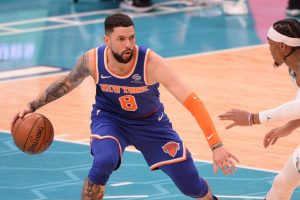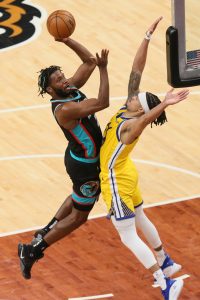It’s been nearly two months since we checked in on the status of 2021’s traded first-round picks, and there have been plenty of shifts in the NBA standings since then. Those changes have an impact on where in the draft certain traded picks will land, as well as whether or not some protected picks will change hands at all.
With just over a month left in the 2020/21 regular season, it’s worth revisiting the traded first-round picks for 2021. With the help of our reverse standings tool, here’s our latest look at which of those traded picks are most and least likely to change hands, and which ones are still up in the air:
Picks that will definitely change hands:
- Knicks acquiring Mavericks‘ pick (unprotected).
- Rockets acquiring Bucks‘ pick (top-nine protected swap).
The only unprotected traded pick for the 2021 draft, the Mavs’ selection currently projects to be the No. 21 overall pick. That would be a reasonably good outcome for the Knicks, but there’s even more upside here — since Dallas is currently the No. 7 seed in the West, a win in the play-in tournament may be necessary to secure a playoff spot.
The NBA has yet to clarify exactly how draft positioning will be affected by the play-in results, but presumably if the Mavs don’t clinch a postseason berth in the play-in, that pick would move into the lottery.
Meanwhile, the Rockets will acquire the Bucks’ pick, currently projected to land at No. 24 overall, in a swap for their own second-rounder (No. 32, for now).
Picks that definitely won’t change hands:
- Grizzlies acquiring Jazz‘s pick (1-7 and 15-30 protection).
- Pelicans acquiring Lakers‘ pick (8-30 protection).
- Rockets acquiring Pistons‘ pick (top-16 protected).
The Jazz are definitely making the postseason and the Pistons definitely aren’t, so their picks (currently projected to be No. 30 and No. 4, respectively) won’t change hands.
The Grizzlies should at least be able to count on getting Utah’s first-rounder in 2022, when it will become top-six protected. It may be a while before the Rockets get a pick from Detroit though — that first-rounder remains heavily protected in 2022 (top-16), 2023 (top-18), and 2024 (top-18) before those protections start to loosen a little.
As for the Lakers‘ pick, it isn’t technically a lock yet — there’s theoretically a scenario in which L.A. misses the playoffs and then moves into the top four in the lottery, sending its pick to the Pelicans. But that’s an extreme long shot. The Lakers’ pick is at No. 23 for now.
It’s also worth mentioning that the Knicks have the ability to swap their own 2021 first-rounder for the Clippers‘ pick. At the moment though, New York’s pick would be No. 15 and L.A.’s would be No. 26, so that won’t happen.
Still up in the air:
- Warriors acquiring Timberwolves‘ pick (top-three protected).
- Magic acquiring Bulls‘ pick (top-four protected).
- Thunder acquiring Warriors‘ pick (top-20 protected).
That Timberwolves pick will be a fascinating one to watch in the lottery. If Minnesota finishes with a bottom-three record, there will be a 40.1% chance it remains in the top three.
The Warriors will actually be rooting for the Wolves to finish with the NBA’s worst record, since in that scenario, there’s a 59.9% chance the pick lands at No. 4 or No. 5. If the Wolves instead have the third-worst record, the pick would be just as likely to land in the top three, but could slip as far as No. 6 or No. 7.
The Magic will have a good chance of landing the Bulls‘ pick, which currently projects to be the No. 10 overall selection. If Chicago remains in that spot, there would only be about a 14% chance of the pick moving up into the top four.
Golden State’s own pick, which currently projects to be No. 13, is unlikely to be sent to the Thunder unless the Warriors get hot late in the season. Assuming the Warriors’ first-rounder is protected, Oklahoma City would instead receive Minnesota’s second-round pick (currently No. 31).
Latest on the Rockets/Thunder/Heat/Blazers/Nets situation:
As a reminder, this series of trades and pick swaps is too convoluted to fit cleanly into any of the above sections. Here’s a breakdown of how it works:
- The Thunder will have the right to swap either their own first-round pick or the Heat’s first-round pick for the Rockets‘ first-round pick, but only if Houston’s pick doesn’t fall in the top four. In other words, if Houston gets a top-four pick, the Rockets will keep their own first-rounder; if not, the Thunder will get the two most favorable picks of their own, the Heat’s, and the Rockets’, and Houston will get the least favorable.
- Once the first step is complete, the Rockets will be left with at least one first-round pick, and almost certainly two, since they’re also owed the Trail Blazers‘ first-rounder (top-14 protected). They would then have the right to swap either of those picks for the Nets‘ first-rounder (unprotected).
As of today, the Rockets have the second-worst record in the league, giving them a 52.1% chance of having their pick land in its top-four protected range on lottery night. In that scenario, Houston would keep its first-rounder (tentatively No. 2) and would get the Trail Blazers’ pick at No. 22. The Thunder would keep their own pick (No. 6, pending lottery results) and receive the Heat’s first-rounder (No. 17), while the Nets would hang onto their own selection (No. 27).
On the other hand, if the Rockets’ pick falls outside of the top four, the Thunder would acquire it along with their own first-rounder, while Houston would get Miami’s pick at No. 17.
No matter how the rest of the season plays out, it’s safe to assume that lottery night on June 22 will have massive implications for the Timberwolves, Warriors, Rockets, and Thunder, and potentially for the Magic and Bulls as well.
While the Pistons, Cavaliers, and a handful of other lottery teams will also be invested in the results that night, the outcome won’t be quite as all-or-nothing for those clubs.
 However, teams may look first as players who have been in the NBA more recently. That list includes vets like
However, teams may look first as players who have been in the NBA more recently. That list includes vets like  Justise Winslow
Justise Winslow